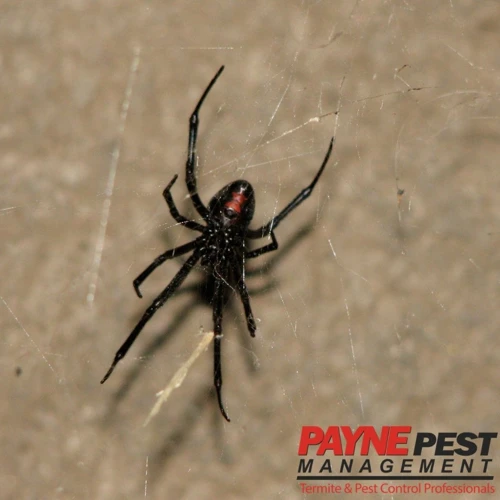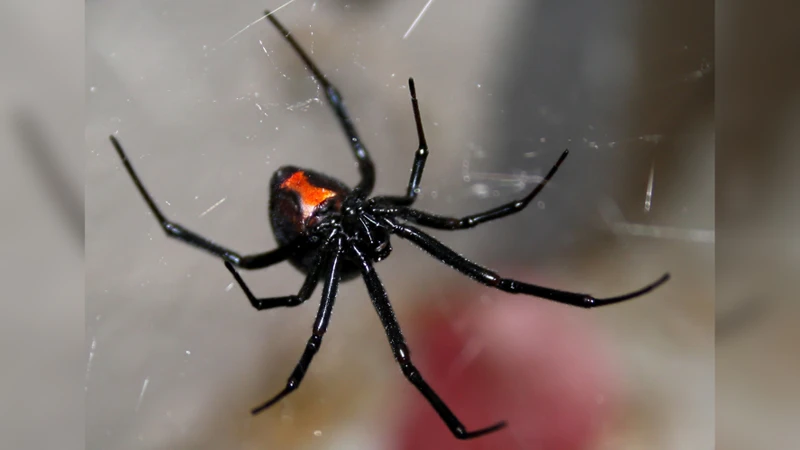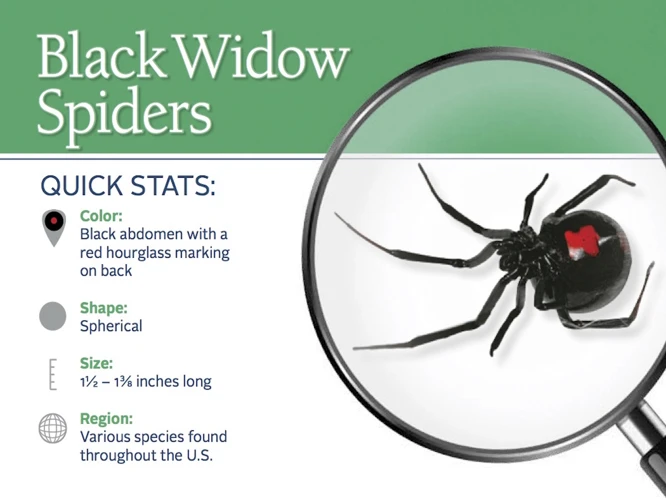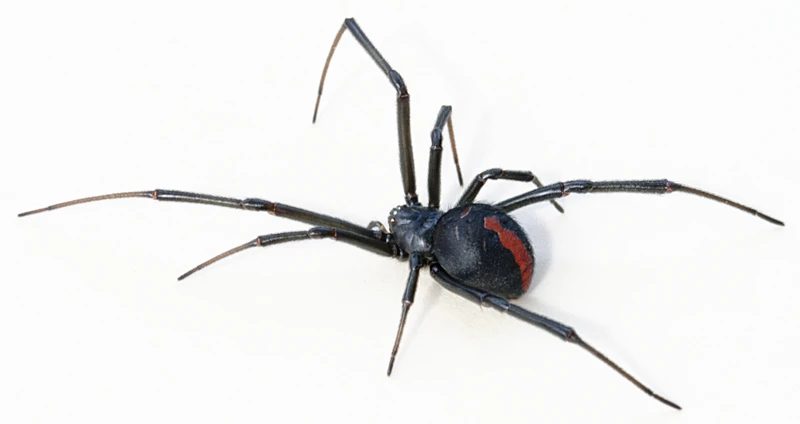One of the most fascinating and feared creatures in the animal kingdom is the black widow spider. These venomous spiders have a notorious reputation for their deadly bite, and their young are just as vulnerable to the challenges of survival in the wild. The question of whether black widow spiderlings have a high or low survival rate is one that has puzzled scientists and nature enthusiasts alike. In this article, we will explore the appearance and life cycle of black widow spiders, the challenges faced by their young, and the survival strategies that enable them to overcome these obstacles. We will also examine the latest research studies and findings on the survival rate of black widow spiderlings in the wild. Let us delve deeper into the fascinating world of these enigmatic creatures and discover the secrets of their survival.
Appearance and Life Cycle of Black Widow Spider

Appearance and Life Cycle of Black Widow Spider
The Black Widow spider is one of the most infamous and recognizable spiders worldwide. Adult female black widows are typically shiny and black, with an hourglass-shaped red or orange mark on the underside of the abdomen. There are five different species of Black Widow, but they share this common appearance. Adult males, on the other hand, are much smaller and lighter in color, usually brown or gray with various geometrical shapes. They display a white or beige band around the edges of the body.
The life cycle of the Black Widow spider begins with the hatching of the eggs. The spiderlings emerge from their silken egg sac, which is produced by the female. The spiderlings are small, white or yellow, and have no markings. The spiderlings go through a series of molts, shedding their skin and growing larger each time. They continue to mature until they reach adulthood, at which point they begin the reproduction cycle.
Sexual cannibalism is a common behavior of female Black Widows. It refers to the behavior of a female spider eating the male spider during copulation or after. Adult females are generally twice the size of males, and this dimorphism is thought to be associated with reproduction. The male Black Widow typically dies soon after mating, and the female may store the sperm for future use or immediately produce an egg sac.
Environmental factors, such as temperature and humidity levels, can play a significant role in the development of Black Widow spider embryos. Research has shown that high temperatures can speed up the development of eggs, leading to faster maturation of spiderlings. Additionally, adequate humidity levels are crucial to the survival of the eggs.
Understanding Black Widow spider’s life cycle and reproductive behaviors are crucial to understanding the survival rate of spiderlings. These factors, along with their unique physical characteristics, are essential in determining the challenges they face in the wild and their survival strategies.
Physical Appearance
The physical appearance of the Black Widow spider is a fascinating and unique aspect of its biology. Known for its characteristic black body, the Black Widow is a sexually dimorphic species with females being significantly larger than males. This difference in size is attributed to the distinct reproductive roles of each sex. Females are the ones who produce the venomous bite for which the species is known and they are the ones who mate and lay eggs. In this section, we’ll explore the physical characteristics of both male and female Black Widows and the implications of their appearance on their survival and reproduction. For more information on Black Widow reproduction, see our article on Black Widow reproduction.
Life Cycle
The life cycle of the black widow spider is similar to other spider species. Female black widow spiders lay their eggs in a silk sac, which can contain hundreds of eggs. This sac is protected carefully by the female until the spiderlings hatch, usually in around 20 days (source). Black widow spiderlings pass through several stages during their growth to maturity.
| Stage | Description | Length of Time |
|---|---|---|
| First instar spiderlings | The hatchlings are about 1 mm long in size and are pale white or yellow in color. They have no ability to regulate their body temperature and rely on their mother’s care. | 2-5 days |
| Second instar spiderlings | The spiderlings shed their skin and become larger (2-3 mm long). Their color also begins to darken, turning from white to beige or light brown. | 5-10 days |
| Third instar spiderlings | During this stage, the spiderlings become larger (4-6 mm long), darker in color, and begin developing the distinctive red hourglass marking on their abdomen that is characteristic of adult black widow spiders. | 10-20 days |
| Fourth instar spiderlings | Spiderlings in this stage have a fully developed hourglass marking and continue to grow larger (6-10 mm long). | 20-30 days |
| Adult | Once spiderlings reach adulthood, they are 13-15 mm long and are sexually mature (source). The males typically live for a shorter duration than the females, living only a few months after reaching maturity (source). The females can live for several years and are able to produce multiple egg sacs during their lifespan (source). | Approximately 90 days from hatching |
It is worth noting that male black widow spiders are significantly smaller than females, with the adult males being about half the size of adult females (source). This size difference may afford males some protection from female aggression or cannibalistic tendencies, especially during mating (source). The survival rate of black widow spiderlings in the wild is low due to several challenges they face.
Challenges Faced by Black Widow Spiderlings

Black Widow spiderlings face a number of challenges in their quest for survival in the wild. Being small and vulnerable, they are easy targets for a variety of predators. Birds, lizards, and other spiders are some of the main predators of Black Widow spiderlings. They may also face competition for resources such as food and shelter from other spider species.
One of the main challenges is cannibalism among Black Widow spiderlings. They are notorious for eating each other, which can drastically reduce the number of spiderlings that survive to adulthood. In fact, studies have shown that cannibalism is the leading cause of death among Black Widow spiderlings.
Another challenge is the dispersion of spiderlings. After hatching from their egg sac, spiderlings disperse from the nest and have to find suitable hiding places and food sources on their own. This puts them at risk of predation and increases their chances of encountering unfavorable environmental conditions, such as extreme temperatures and humidity.
However, Black Widow spiderlings have developed several survival strategies to overcome these challenges. Cannibalism, while harmful to their siblings, is also a means of survival for the strongest and most aggressive spiderlings. It ensures that only the fittest spiderlings survive, improving the overall genetic quality of the population.
Black Widow spiderlings also disperse widely, reducing competition for resources and increasing the likelihood of survival. They may use pheromones to locate each other when environmental conditions are unfavorable, helping them to form groups and reduce the risk of predation.
Studies have shown that temperature and humidity also play a crucial role in the survival of Black Widow spiderlings. High temperatures and low humidity can significantly reduce their survival rates, while moderate temperatures and humidity levels can improve their chances of survival.
While Black Widow spiderlings face numerous challenges in the wild, their unique survival strategies allow them to thrive in many different environments. By cannibalizing weaker spiderlings, and dispersing widely to reduce competition, they are able to survive and pass on their genes to the next generation of Black Widow spiders.
Predators
The survival rate of Black Widow spiderlings in the wild is extremely low due to various challenges. Predation is one of the most significant factors that affect the survival of these spiderlings. Black Widows have several natural predators that feed on these spiderlings, such as birds, lizards, and other spider species. Birds are particularly deadly predators of Black Widow spiderlings. They can easily spot and capture these small spiders while they are still developing.
Competition for Resources
Black widow spiderlings face fierce competition for resources from their siblings. This competition starts even before they hatch from their eggs, with the size of egg and mother’s investment in nutrition affecting their survival and development. After hatching, they need to compete for food, water, shelter, and warmth in order to grow and mature. The competition is particularly intense in crowded nests or locations with limited resources, such as crevices, cracks, or leaf litter.
Food: Black widow spiderlings are carnivorous and feed primarily on small arthropods, such as mites, springtails, and flies. However, the availability and quality of prey can vary greatly depending on the season, location, and habitat. In some cases, there may be a shortage of prey due to drought, flooding, or other disturbances, which can lead to starvation, malnutrition, or cannibalism among spiderlings. To improve their chances of survival, spiderlings may develop specialized feeding behaviors, such as gregarious feeding, where they feed in groups, or kleptoparasitism, where they steal food from each other or their mother.
Water: Black widow spiderlings also need water to survive, but they have limited options for obtaining it in the wild. They may drink from dew, rain, or other sources, but these are not always available or reliable. Drinking from open surfaces may expose them to predators or pathogens. To avoid dehydration, spiderlings may stay close to their egg sac or nest web, where the humidity is higher, or they may reduce their activity and metabolism to conserve water.
Shelter: Black widow spiderlings need shelter to hide from predators, regulate their body temperature, and molt safely. However, they have to share the space with their siblings and other arthropods, which can complicate their survival. They may use silk to create communal webs or individual retreats, but the quality and location of these structures can affect their vulnerability to predation or desiccation. They may be exposed to chemical cues from their competitors or other spiders, which could influence their behavior and physiology.
To illustrate the competition for resources among black widow spiderlings, a study conducted by Johnson and colleagues (1990) found that the survival and growth rates of spiderlings varied depending on the size of their egg sac, the number of siblings, and the quality of their diet. Spiderlings from larger egg sacs had higher survival rates and body weights than those from smaller egg sacs. Spiderlings reared in isolation had higher survival rates and body weights than those reared in crowded conditions. Spiderlings fed on a high-quality diet (Drosophila melanogaster) had higher survival rates and body weights than those fed on a low-quality diet (mite eggs). These findings suggest that the competition for resources plays a crucial role in the survival and development of black widow spiderlings in the wild.
If you want to read more about black widow spiders, you can check out our article on pheromones and reproduction, our article on diet and nutrition, or our article on temperature and humidity.
Survival Strategies of Black Widow Spiderlings

Black widow spiderlings are born with the innate ability to quickly develop survival strategies to increase their chances of survival in the wild. These strategies include cannibalistic behavior, dispersal, and adaptation to various environments.
Cannibalistic Behavior: While it may seem gruesome, cannibalism plays a crucial role in a black widow spiderling’s survival. They often consume their own siblings in order to reduce competition for resources. This behavior ensures that the strongest and most resilient spiderlings survive.
Dispersal of Spiderlings: To avoid overpopulation, black widow spiderlings scatter themselves into the surrounding environment upon hatching. By doing so, they reduce the chances of being detected by predators and increase their chances of finding food and shelter. Dispersal also allows for genetic diversity, which is an important factor in a species’ survival.
Adaptation to Environments: Black widow spiderlings are able to adapt to many different environments, from forests to deserts. Their bodies have evolved to suit a range of temperatures and humidity levels. Additionally, they are capable of producing pheromones that signal to other spiders that there are resources present. These pheromones can attract potential mates and help the spiderlings find food and shelter. (Learn more about pheromones and black widow spider reproduction.)
The black widow spiderlings’ survival strategies demonstrate their impressive ability to adapt and overcome challenges in the wild. Their innate behaviors, such as cannibalism and dispersal, and physiological adaptations, such as pheromone production, allow them to thrive in a variety of environments.
Cannibalistic Behavior
As creepy as it may sound, cannibalism is a common practice among black widow spiderlings in the wild. Despite being siblings, the survival of the fittest mentality dominates among these arachnids. This cannibalistic behavior is one of the key survival strategies black widow spiderlings employ to ensure they make it to adulthood. Let’s dive deeper into this brutal survival tactic.
Dispersal of Spiderlings
Upon hatching, black widow spiderlings face the challenge of dispersing away from their mother’s web to find their own territory. One strategy for achieving this is through “ballooning.” The spiderlings release a silken thread that catches the wind, allowing them to be carried to a new location. According to recent research studies, dispersal by ballooning may increase the survival rate of black widow spiderlings.
Another method of dispersal is through active movement, where the spiderlings crawl away from their mother’s web. This can be dangerous as they have to traverse through unfamiliar terrain and face the risk of encountering predators. Additionally, it can be challenging to find a suitable location with enough resources to support their growth.
To better understand the dispersal strategies of black widow spiderlings, researchers have conducted studies on the effects of habitat quality and availability on the survival rate. According to recent findings, black widow spiderlings have a higher survival rate when they disperse to habitats with low competition and high resource availability. This suggests that black widow spiderlings are capable of evaluating their environment and making decisions to increase their chance of survival.
To summarize, dispersal is a crucial strategy for the survival of black widow spiderlings. By using ballooning or active movement, they can move away from their mother’s web to find a suitable location. The success of their dispersal is influenced by habitat quality and resource availability, and research indicates that dispersal may increase their survival rate.
Adaptation to Environments
The Black Widow Spiderlings have adapted to their environments over the years, allowing them to survive in a wide range of ecosystems. Here are some of the adaptations that have enabled them to thrive:
- Web Building: As soon as the spiderlings hatch from their egg sac, they start producing silk to make webs that protect them from threats and provide a secure place to rest. This unique ability allows them to adapt to a range of environments, including deserts, forests, and coastal areas.
- Camouflage: Black Widow Spiderlings are able to adapt to different environments by blending in with their surroundings. For example, spiderlings in coastal areas have a lighter coloration because their habitat is typically rocky and light in color. This allows them to blend in with their surroundings, making it difficult for predators to spot them.
- Feeding Habits: Black Widow Spiderlings have adapted to different environments by adjusting their feeding habits. For example, spiderlings in arid areas may consume less food and water to conserve energy, while those in more humid areas may consume more food and water.
- Behavioral Adaptations: Black Widow Spiderlings have also adapted their behavior to different environments. For example, spiderlings in denser forests may be more aggressive toward predators, while those in more open areas may be more prone to hiding or fleeing when threatened.
These adaptations have allowed Black Widow Spiderlings to survive in a range of habitats, despite the numerous challenges they face as they grow and mature. By being able to adapt quickly to changes in environment and behavior, they can better avoid predators and secure resources necessary for their survival.
Research Studies on Survival Rate
Numerous research studies have been conducted on the survival rate of Black Widow spiderlings in the wild, providing valuable insights into their behavior and adaptations. These studies are crucial in understanding the factors that affect the survival of these spiders, which can have implications for the overall balance of ecosystems.
One study, conducted by researchers at the University of Kentucky, found that the survival rate of Black Widow spiderlings can vary significantly depending on the availability of resources. In areas with high prey abundance, spiderlings were found to have better survival rates. However, in areas lacking proper resources, the survival rate of spiderlings dropped significantly.
Another study, published in the Journal of Arachnology, focused on the cannibalistic behavior of Black Widow spiderlings. The study found that spiderlings are extremely aggressive and will often cannibalize nestmates for resources. This behavior can have a significant impact on the survival rate of spiders, as weak and undernourished spiderlings are more likely to be cannibalized by their siblings.
Research studies have also shown that Black Widow spiderlings have adapted to their environments through various behaviors, such as ballooning. Ballooning is a process by which spiderlings use their silk fibers to float away from their nest and disperse to different areas, allowing them to find better resources and avoid overcrowding.
Recent studies have also highlighted the impact of climate change on the survival rate of Black Widow spiderlings. As temperatures continue to rise, spiderlings may face new challenges in adapting to their changing environments. Research studies have suggested that the survival rate of Black Widow spiderlings may decrease in warmer temperatures, as the spiders require certain conditions to thrive.
Research studies have provided valuable insights into the survival rate and behavior of Black Widow spiderlings in the wild. These studies offer important information for conservation efforts and understanding the complex dynamics of ecosystems.
Recent Studies and Findings
Recent studies and findings have shed light on the survival rate of Black Widow spiderlings in the wild. One study conducted by researchers at the University of California, Riverside, examined the effects of temperature on the survival of Black Widow spiderlings. They found that spiderlings reared at lower temperatures had higher mortality rates than those reared at higher temperatures.
Another study published in the Journal of Arachnology found that spiderlings of the Northern Black Widow species exhibited higher survival rates when they were reared communally rather than in isolation. This suggests that social behaviors play an important role in the survival of Black Widow spiderlings.
Additionally, research has shown that Black Widow spiderlings exhibit a high degree of phenotypic plasticity, which allows them to adapt to varying environmental conditions. This adaptability enables them to survive in different habitats and cope with different challenges such as food scarcity and predation.
A study published in the Journal of Insect Science found that Black Widow spiderlings exposed to different types of prey exhibited different growth rates and survival rates. This suggests that the availability of prey has a significant impact on the survival rate of Black Widow spiderlings.
These recent studies show that Black Widow spiderlings have a variety of survival strategies at their disposal, including phenotypic plasticity and social behavior. However, their survival is still influenced by environmental factors such as temperature and prey availability. Further research in this area is needed to fully understand the complex dynamics that impact the survival rate of Black Widow spiderlings in the wild.
Conclusion
In conclusion, the survival rate of Black Widow spiderlings in the wild is low due to various challenges they face. Predation and competition for resources are among the major threats to their survival, but they have evolved several strategies to overcome these obstacles. One such survival strategy is cannibalistic behavior—they eat their siblings to eliminate competition for food and resources.
Another strategy employed by Black Widow spiderlings is dispersal, where they move to new habitats in search of food and other resources. They also adapt to their environments, developing unique features and behaviors to better survive in different conditions.
Despite these survival strategies, research studies have shown that the mortality rate of Black Widow spiderlings is notably high. Recent findings suggest that only a small percentage of young Black Widow spiders survive to adulthood.
Therefore, it is essential to understand the challenges faced by Black Widow spiderlings, their survival strategies, and survival rates to protect this species. Further research studies on the Black Widow spider’s survival rate can help identify ways to mitigate the challenges they face and increase their chances of survival in the wild. Overall, the Black Widow spider’s fascinating behavior and remarkable adaptations shed light on the amazing resilience of nature and the never-ending struggle for survival.
Frequently Asked Questions
What is the average lifespan of a black widow spiderling?
The average lifespan of a black widow spiderling is around 1 year.
How big is a black widow spiderling at birth?
A black widow spiderling is usually less than 1/8 inch in size at birth.
What are the predators of black widow spiderlings?
The predators of black widow spiderlings include birds, reptiles, and other larger spiders.
Do black widow spiderlings have venom?
Yes, even black widow spiderlings have venom, but it is not as potent as adult black widows.
What is cannibalistic behavior in black widow spiderlings?
Cannibalistic behavior in black widow spiderlings is when they eat other spiderlings or their own siblings for survival.
How do black widow spiderlings disperse?
Black widow spiderlings usually disperse by “ballooning,” which involves using strands of silk to catch air currents and travel to new environments.
What is the competition for resources faced by black widow spiderlings?
Black widow spiderlings face competition for resources such as food, shelter, and mates from other spiderlings and insects in their environment.
What are the adaptations of black widow spiderlings to survive?
Black widow spiderlings have adapted to survive by developing venom, using their silk to create shelters, and dispersing to new environments.
What are recent findings on the survival rate of black widow spiderlings in the wild?
Recent studies have shown that the survival rate of black widow spiderlings is highly dependent on environmental factors, and that cannibalism and dispersal are important strategies for survival.
What can we learn from studying black widow spiderlings?
Studying black widow spiderlings can provide valuable insights into the evolution and adaptation of invertebrate species, as well as the role of cannibalism and dispersal in survival strategies.






